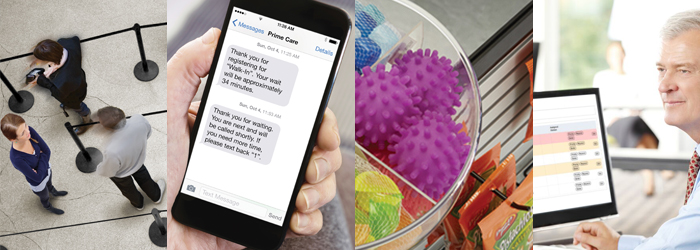
La Incomprendida Fila de Espera de una Sola Línea
Retail and grocery store customers, filled with a deep desire to get through the checkout line as quickly as possible, have unknowingly supported a less-than-ideal waiting line system. Our own field studies have shown customers tend to perceive a traditional multi-line, multi-server queuing system as offering shorter wait times than a single line queue leading to multiple servers. That is, until they get slighted. Turns out, the gamble of choosing the line that is actually the shortest doesn't appear risky until after a customer glances to their left and realizes they have been waiting significantly longer than the person who just checked out at the station next to them. Although approaching multiple shorter lines feels like a better deal, in reality, it’s not.
Why customers are hesitant about a single line queue
Research has proven that a single line, multi-server waiting system is faster than the multiple line approach. But if this statement is true, why haven’t more retailers and grocers switched systems? Because the switch doesn’t come without risk. Often customers dislike the look of a long line snaking around several turns. Seeing nine people waiting in one line instead of three people in three different lines can be deceiving for an uneducated customer. He or she may immediately balk by seeing the number of people in line stretching beyond what they consider the norm. If they relate a three person wait with four minutes in a traditional system, they may automatically think a nine person wait will take twelve minutes neglecting to take into account that the single line is feeding to three cashiers through a more efficient system.
Why a single line is the best choice

A recent BusinessInsider article, Why You’re Drawn to Slower Checkout Lines, points out there's a reason people always feel like they chose the "wrong line" in a multiple line environment and it relates to the fact that there is just too much variation in the time a customer can end up waiting. For example, in a three line, three register environment, the probability an individual will be in the fastest line is only one in three. Additionally, the gap between the shortest and the longest wait is usually an extremely unfair spread. So it’s not just a mental game, more times than not the customer is in a slower line. What happens when you, as a retailer or grocer, make the switch to a single line queue? Average wait times will decrease. In addition to reducing wait times, your customers will benefit from the following:
- They can simply jump in line without having to stop, choose, and then fret about which line they are in.
- If a hang up occurs at one cashier, they do not have to worry that it occurred in the line they chose. Instead, the single line will keep flowing to another point of service.
- An impartial waiting and checkout system that automatically enforces the first come, first served rule, a universal truth in fairness.
Your customers and your business deserve a single line queue to improve service efficiency, reduce actual average wait times, and achieve greater overall customer satisfaction. The question is: Can you convince your customers?
SUSCRIBIRSE
Suscríbase para mantenerse al día con los nuevos productos, información y noticias sobre los recursos.
ENTRADAS DE BLOG RECIENTES
Rapid Deployment Crowd Control: JetTrac Portable Barriers For The Biggest Spaces
Leer el artículo completo4 Psychological Reasons Your Customers Hate Waiting In Line
Leer el artículo completoFrom Bleachers To Bookstores: 4 Campus Crowd Control Solutions
Leer el artículo completoCrowd Control Systems for Large Venues
Leer el artículo completo








